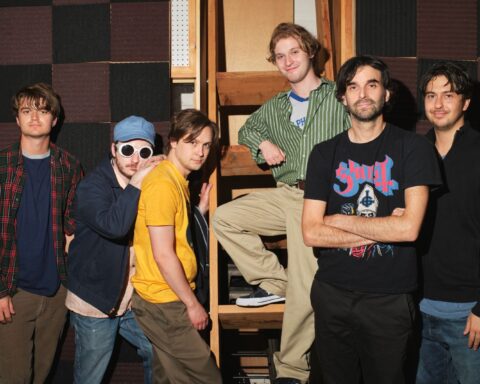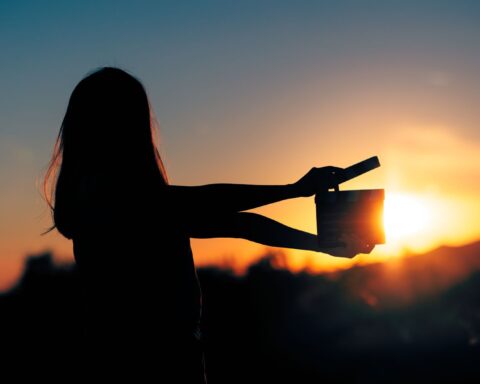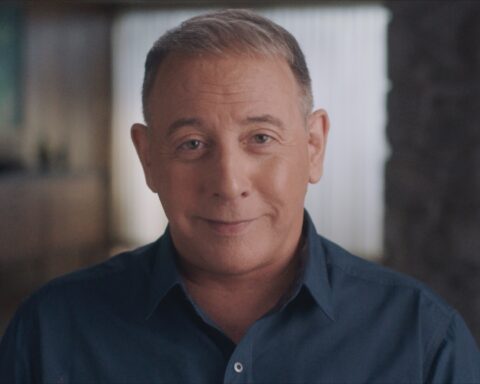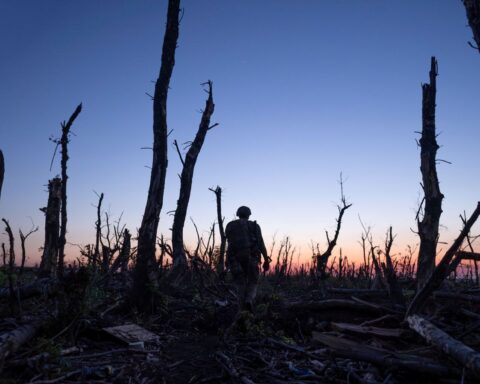The next time you walk down Gerrard Street, take note of the bright sparkly motorcycle parked on the south side of the street just opposite Allan Gardens. The bike marks the spot for Paddy Alridge’s speciality boutique Take a Walk on the Wild Side, which creates a safe and easygoing space for the cross-dressing men of Toronto to find the right clothes, wigs, and accessories for transformation. Alridge’s shop and larger-than-life personality are the subject of the short doc Take a Walk on the Wild Side by Ryerson Documentary Media grad Lisa Rideout. The film observes the goings-on in the store as Paddy’s bubbly personality creates a warm and inviting community where Torontonians can shed their disguise and be themselves. It’s a fun and refreshing observation of the actions that one person can take to give confidence and comfort to many.
Take a Walk on the Wild Side debuts at Hot Docs this week and POV sat down with Rideout to chat about her new short doc.
POV: Pat Mullen
LR: Lisa Rideout
POV: How did you first meet Paddy?
LR: I first met Paddy when I was scouting her store as a location for a different film. As soon as I went into the store, I thought it was very interesting visually—it was covered in these different objects—and for a filmmaker, each object tells a different story. I found that intriguing. Also, meeting Paddy—
POV: —she’s such a character!
LR: She’s a great character with a wonderful personality. A strong personality. That’s really helped her succeed. She’s had the business for 30 years, so clients come in with different stories. One that she told me about was a priest who came into the store because he had someone from his church cross-dress and he didn’t know how to stop, so the priest was like, ‘I’m going to cross-dress to try and get into their mind.’
POV: Wow, that is amazing. And with the customers who came in, were there many who were reluctant to have the story told?
LR: The process of the production was that I sat in the store while Paddy was open and just observed her. When people would come into the store, Paddy would ask, ‘Are you comfortable speaking to Lisa?’ Some would say no and some would say yes. I found the majority of people were quite open. The first day I was in the store, this business-type from the financial district came in with his collared shirt and bought a gigantic pair of double-d breasts, a little skirt, and then said he wasn’t comfortable talking and left.
POV: Oh, there’s a story there.
LR: 30 minutes later, he called Paddy’s store and asked, ‘Is the filmmaker still there?’ He offered to meet and chat with me because he felt it was a very important story. Then we sat and chatted for two hours about his life. So, I found that people did want to speak to me, but didn’t necessarily want to do so on camera.
POV: That’s interesting.
LR: I chatted with them and established trust, but Paddy’s relationship with them was instrumental in building that trust.
POV: I guess it really helps when you have a go-between from the community who supports you. I noticed that her clients in the film seem a fair bit older. Was that consistent in your experience, like a generational gap?
LR: I think it skews on the older side because she has a lot of repeat customers over 30 years. Someone who is 18 might go online to buy their clothes, but she does have some younger customers.
POV: What did you learn about body image while making the film? I’d just seen Mermaids before watching the film, which deals with similar themes of people finding comfort through dressing up, etc., and last year’s festival had Tempest Storm and League of Exotique Dancers, both films about mature women, sexuality, and looking at women of different types.
LR: Like those films, this revealed the central part of having a community for people to express themselves, especially when the community has historically been ostracised from society. It was amazing to see this space that Paddy created where people could transform and gain confidence in their own skin.
POV: You’d mentioned that when you visited that space, certain things caught your attention?
LR: As soon as you walk in, there’s a variety of mannequins with wigs and I thought that was something you could photograph very well—
POV: —which you do in the film very nicely.
LR: It’s quite a colourful space and the clothes are very over the top in some ways—six inch sparkly heels and spiky clothing—all that caught my eye.
POV: I really like the tone of the film, too. It’s funny, but respectful. How did that environment come about—laid back and non-judgemental?
LR: The tone and the style came out of my experience in the store with Paddy and observing her. It’s quite hard when you’re making a short film to let the entire story come about. The great way to do that was by observing people in the store in a slice of life way from opening to closing. That way, you’re just observing people and the humour comes out of Paddy. You’re observing that humour; you’re observing that relationship she has with the customers. That tone was important for me because my aim was to make a film that would reach people who might not immediately see a film about cross-dressing. Rather than overtly hammer an overtly political message, it lets them simply observe people as people.
POV: I’ve noticed that there are many films at the festival, more than usual, that are especially character driven. They focus on one person and use that portrait to extend to larger issues. Did having a specific character like Paddy help get the film off the ground?
LR: What really helped with selling the film was Paddy’s big personality and the fact that it was a first-person p.o.v. character-driven documentary. I also think that Paddy’s being established in the community for 30 years was important for selling it. She’s has a large amount of media coverage and is a bright personality. If you’re making a film that centres on one person, they have to have a big enough personality to carry it.
POV: What about in terms of Ryerson and the Doc Media programme? One benefit of being in Toronto is the great film culture.
LR: I wouldn’t be a documentary filmmaker without Ryerson. Both going through the programme and having the hard skills at the end as well as working with that community—as you see this year, so many people from the doc programme have a film at the festival. One of the things that’s challenging about being a documentary filmmaker is that it’s not like narrative where you have a huge team behind you. Having a big community like Ryerson where you can call people and ask for help is essential. And you have people who are going to give you honest feedback.
POV: And what about some of the veterans on the film? One of the editors on your short is Lawrence Jackman, who’s at the festival with A Better Man. On that film, his co-director, Attiya Khan, said that having a mentor was essential on her debut.
LR: Avril Jacobson was the main editor and then Larry came on after. They’re both veterans in their own right. Avril took such care with the characters. The best doc editors respect them and get what’s going on. She really put the framework in motion. Larry came at the end with a fresh perspective. He helped cut a character, which was definitely the right choice.
POV: That must be difficult. How do you choose who stays and who goes?
LR: We had to cut two people. With documentary, it’s not like they’re actors. They’re not getting paid. They gave their stories and their time. I wanted to show diversity in the film since Paddy’s clientele is so diverse, but the two people who were cut from the film were people of colour. That was quite hard for me. I’m very aware of the critique [of needing representation in a doc] because you don’t want to show only one portion of the community. But their stories didn’t fit and it was the right decision in the end.
POV: The film still spotlights a community that often doesn’t have its voice heard.
LR: Especially since it spotlights an older demographic. Another great mentor was our executive producer Lauren Grant. Being surrounded by people who have done this over and again helps a film in ways you hadn’t expected.
POV: Had you worked with her before? Her previous film [ Traceable ] was a documentary about fashion.
LR: I worked with her on a feature in the making—the one that originally led me to Paddy. It’s a film about Susan Gapka, who’s a trans activist. Lauren’s the executive producer on that.
POV: How do you feel about jumping into the doc field when so much is changing in terms of how films are being made, broadcast, played, streamed, etc.? Are you optimistic?
LR: You have to be optimistic. In Canada, we have access to a fair amount of funding, especially for shorts. This process taught me to focus on shorts for a while since they are manageable. The reality is that you have to balance it with another job. I do commercial work in addition to documentary.
POV: That works, actually, since the film has such a great visual sense of the store.
LR: It’s just practicing your craft whenever you can, regardless of the environment or whether it’s a commercial or documentary. Practicing your craft will only make you better.
Take a Walk on the Wild Side screens:
Monday, May 1 at Cineplex Scotiabank at 12:00 PM








